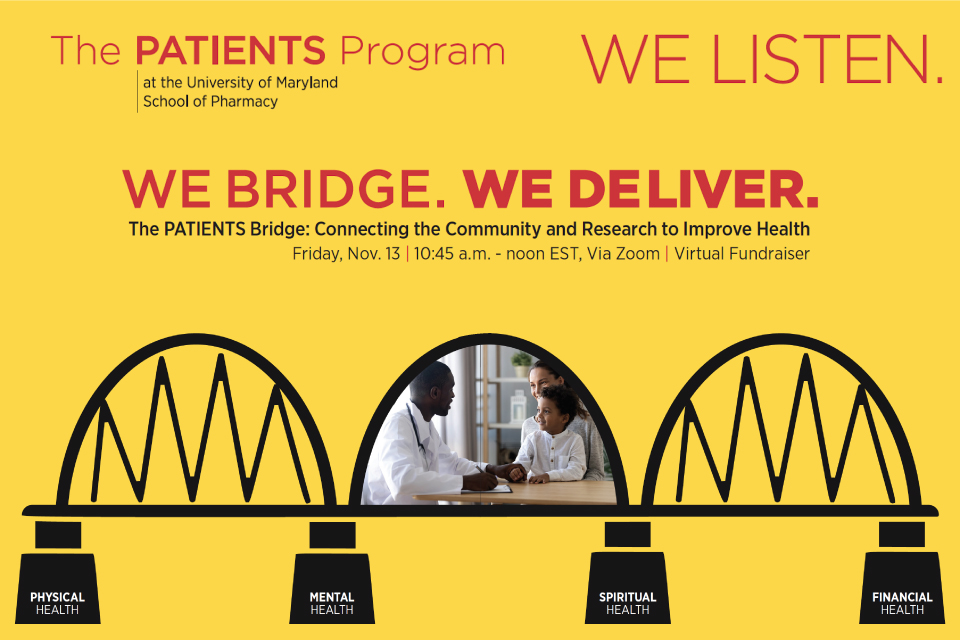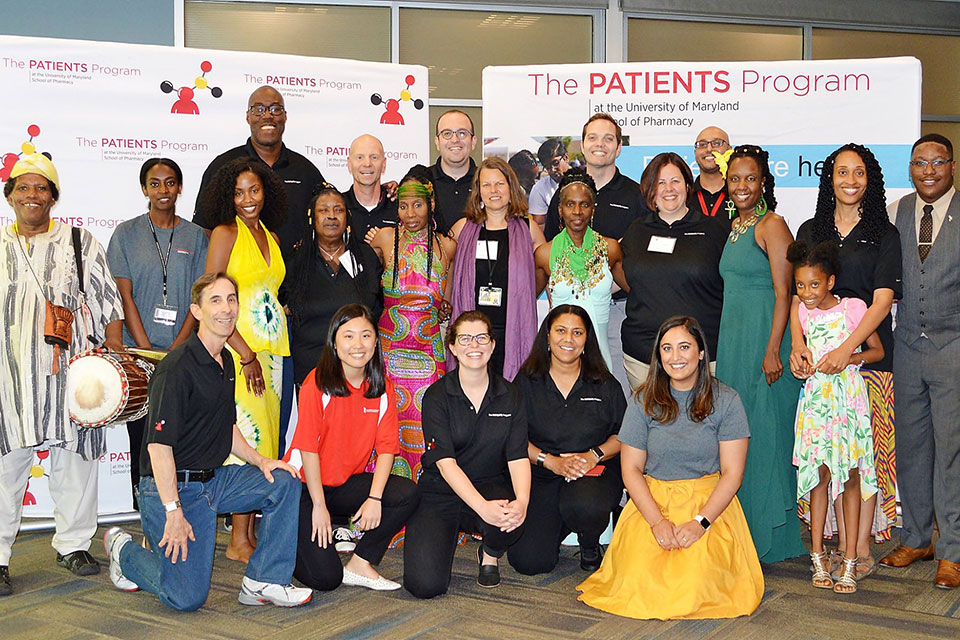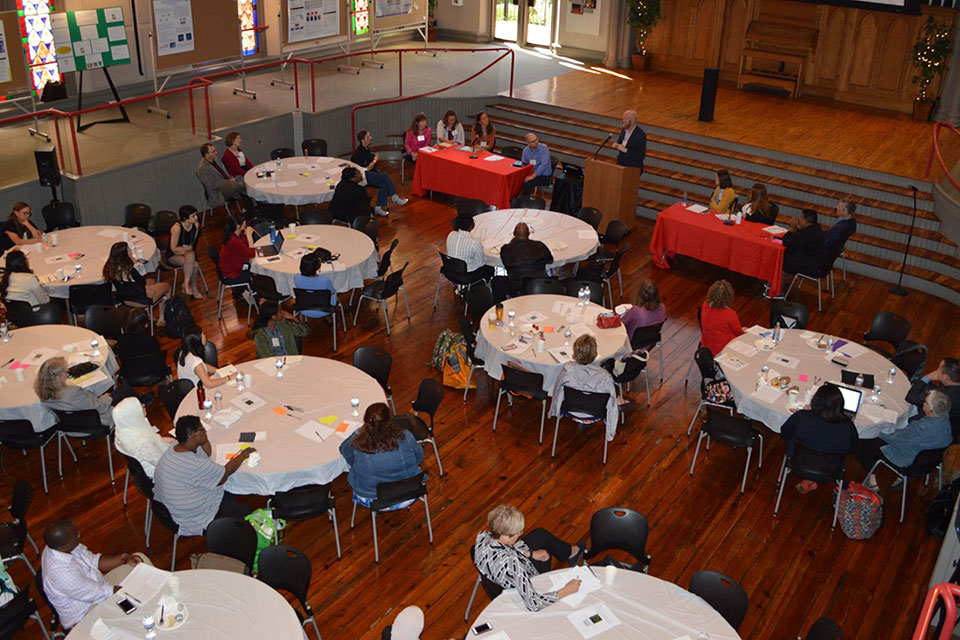PATIENTS Conference Showcases National Efforts to Build Capacity for Patient-Centered Research
Presentations from academic institutions and health care systems across the United States shared best practices and strategies to support the continued advancement of patient-centered outcomes research.

By Malissa Carroll
August 7, 2020
To help share best practices and strategies to support the continued advancement of patient-centered outcomes research (PCOR) across the United States, The PATIENTS Program at the University of Maryland School of Pharmacy hosted a day-long conference titled “Building Capacity for Patient-Centered Research” on June 19. More than 200 researchers, patients, community members, and other stakeholders attended the conference, which was held virtually to help safeguard the health of all attendees during the ongoing COVID-19 pandemic.
The event also served as encore to The PATIENTS Program’s 2019 “Making Learning Healthcare Systems More Patient-Centered” conference, bringing together researchers and patient partners from the seven institutions that received five-year infrastructure development grants from the Agency for Healthcare Research and Quality (AHRQ) in 2013.
“Because we have learned so much from our patient and community partners, as well as our partner institutions and health care systems, we wanted to host an event that would allow us to share best practices and lessons learned with others, so that they can begin to build the capacity to conduct PCOR as well,” said C. Daniel Mullins, PhD, professor and chair of the Department of Pharmaceutical Health Services Research (PHSR) at the School of Pharmacy and executive director of The PATIENTS Program in his opening remarks. “I hope that today, on Juneteenth, we not only discuss how we can improve patient-centered research, but also understand the broader missions of all of our institutions, which is to improve health care decision making, to promote health equity, and to address those social determinants of health that will allow us to improve both health equity and social justice.”
The conference was divided into three sessions, with presentations that focused on strategies to help build capacity and institutional support for PCOR, methods to implement community engaged research and PCOR partnerships, and tools to help better disseminate research results and best practices.
All presentations were delivered jointly by researchers and community partners from each participating institution.
“The unique delivery of the presentations reinforced the importance of partnership among patients, community advocates, and researchers, further emphasizing how these collaborations play a key role in implementing and conducting PCOR,” said Harry Kwon, PhD, MPH, MCHES, director of the Division of Research Education in the Office of Extramural Research, Education, and Priority Populations at AHRQ. “It is important to recognize the crucial role that patients and community members, including advocates and advisors, play in working together with researchers and others to improve how research is conducted, ensuring that it incorporates elements that matter to patients, and ultimately, helps to improve patient outcomes. The best practices and lessons learned shared today will provide the ‘wind behind the sails’ to help others integrate PCOR in health system research, with the aim to improve quality of care and outcomes for all patients.”
The first session focused on capacity building and institutional support for PCOR and featured presentations from The PATIENTS Program, Denver Health, and Indiana University. The PATIENTS Program presentation delivered by Mullins and Gail Graham, director of HIV/AIDS outreach services at Mt. Lebanon Baptist Church and community partner with The PATIENTS Program, highlighted the benefits of community-academic partnerships, while speakers from Denver Health and Indiana University focused on how to establish a culture of patient-centered research in an integrated safety net health care system and essential resources for engaging patient and community partners in cancer research, respectively.
Presentations delivered during the second session focused on best practices and strategies to help implement comparative effectiveness research (CER) and PCOR partnerships. Representatives from the Henry Ford Health System spoke about their efforts to implement a flexible engagement model for PCOR partnerships, while speakers from the University of Texas Southwestern Medical Center showcased how their institution engaged medical students in service learning to help build sustainable community partnerships.
The conference’s final session took a deeper dive into best practices surrounding the dissemination of research results. Representatives from the University of Missouri highlighted their work to engage patients in an early review of proposed research projects to help make those projects more patient-centered. Another presentation delivered by the University of Texas Medical Branch examined how the dissemination of research results back to the community can act as a catalyst for continued community partnerships.
“Just as evaluation is built into all research studies, dissemination must go right along with it – you cannot have one without the other,” emphasized John Cooks, a community partner with the University of Texas Medical Branch. “When community inclusion is present throughout the entire research process, it becomes even more crucial that you get the results out there in a way that meets community members where they are. This will not only help the community understand just how much buy-in they have in a study, but also get them totally onboard with other efforts in the future. And, we know that the more community input you have, the richer and better your research will be.”
Initially funded with a $5 million grant from AHRQ, The PATIENTS Program is committed to listening to the voice of the community, bridging research and the community, and delivering solutions that are important to the community. The program works to build partnerships with local, regional, and national patient communities and health care systems; conduct and expand PCOR to help patients make more informed health care decisions.
“The PATIENTS Program has been co-presenting with patients since we started our program seven years ago,” says Mullins. “It was truly rewarding that a co-presentation format was used by all seven participating institutions during our conference. If we want patients and communities to be actively involved in improving health and well-being, they need to be involved in the learning and dissemination process – that’s exactly what patient-centered research is all about.”
To learn more about The PATIENTS Program, visit its website at patients.umaryland.edu.



